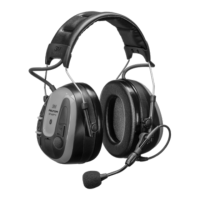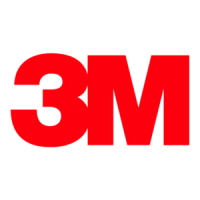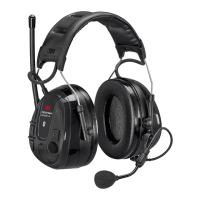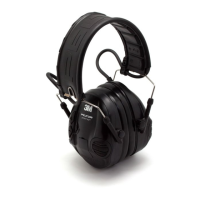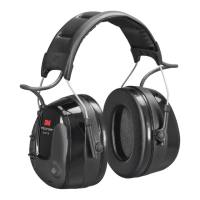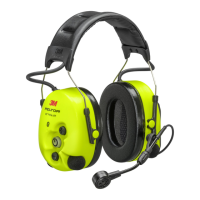2
EN
EN 352 Safety Statements:
• The tting of hygiene covers to the cushions may affect the
acoustic performance of the earmuffs.
• Performance may deteriorate with battery usage. The typical
period of continuous use that can be expected from the
earmuffs battery is approximately 70 hours. This product
may be adversely affected by certain chemical substances.
Further information should be sought from the manufacturer.
• The entertainment audio signal does not exceed 82 dB (A)
for input voltage up to maximum value 500 mV. The product
shall not be used if it can’t be ensured that the input voltage
doesn’t exceed the maximum value.
2.2. CAUTION
• Risk of explosion if battery is replaced by an incorrect type.
• Do not charge batteries in temperatures above 45°C (113°F).
• Only use AA or AAA non-rechargeable (as applicable) or
3M™PELTOR™Ni-MH rechargeable LR6NM or LR03NM
(as applicable) batteries. These rechargeable batteries might
not be available in all markets.
• Always use product-specic 3M replacement parts. Use of
unauthorized replacement parts may reduce the protection
you receive from this product.
2.3. NOTE
• When worn according to these User Instructions, this
hearing protector helps reduce exposure to both continuous
noises, such as industrial noises and noises from vehicles
and aircraft, as well as impulse noises, such as gunre.
It is difcult to predict the required and/or actual hearing
protection obtained during exposure to impulse noises.
For gunre, the weapon type, number of rounds red, proper
selection, t and use of hearing protection, proper care of
hearing protection, and other variables will impact
performance. To learn more about hearing protection for
impulse noise, visit www.3M.com.
• This hearing protector is provided with level-dependent
attenuation. The user should check correct operation before
use. If distortion or failure is detected, the user should refer
to the manufacturer’s advice for maintenance and
replacement of the battery.
• Operating temperature range: –20°C (–4°F) to 50°C (122°F).
• Do not mix old and new batteries.
• Do not mix alkaline, standard, or rechargeable batteries.
• To properly dispose of the battery, follow local solid waste
disposal regulations.
• Attention – Product imagery is for illustration only.
3. APPROVALS
All the approvals referred in this section might not apply to
your product. If some approvals doesn’t apply to your product,
this can be seen on the label(s) on the product.
3.1. EUROPEAN APPROVALS
EU
Hereby, 3M Svenska AB declares that the
radiobroadcast reciever is in compliance with Directive
2014/53/EU and other appropriate directives to fulll the
requirements for the CE marking.
3M Svenska AB also declares that the PPE type hearing
protector is in compliance with Regulation (EU) 2016/425.
The PPE is audited annually and type approved by SGS
Fimko Ltd.,Takomotie 8, FI-00380 Helsinki, Finland, Notied
Body No. 0598.
The product has been tested and approved in accordance
with EN 352-1:2020, EN 352-3:2020, EN 352-4:2020 and
EN 352-8:2020.
The applicable legislation can be determined by reviewing the
Declaration of Conformity (DoC) at www.3M.com/peltor/doc.
The DoC will show if some other type-approvals are also
applicable. When retrieving your DoC, please locate your part
number.
The part number of your earmuffs can be found at the bottom
of one cup. An example can be seen in the picture below.
A copy of the DoC and additional information required in the
Regulations and Directives can also be obtained by
contacting 3M in the country of purchase. For contact
information, see last pages of this user instruction.
4. EXPLANATION OF STANDARD TABLES
The sound attenuation was obtained with the device powered
off.
4.1. EUROPE
3M strongly recommends personal t testing of hearing
protectors. Research suggests that users may receive less
noise reduction than indicated by the attenuation label
value(s) on the packaging due to variation in t, tting skill,
and motivation of the user. Refer to applicable regulations
and guidance on how to adjust attenuation label value(s). In
the absence of applicable regulations, it is recommended that
the attenuation label value(s) be reduced to better estimate
typical protection.
4.2. EUROPEAN STANDARD EN 352
EN 352-1, EN 352-3 Sound attenuation and sizing
Table ref. Description
A:A Headband earmuffs with foam cushions
A:B Carrier attachment earmuffs with foam
cushions
A:1 f = Octave-band centre frequency (Hz)
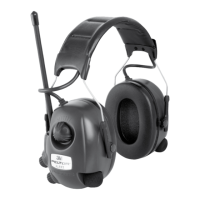
